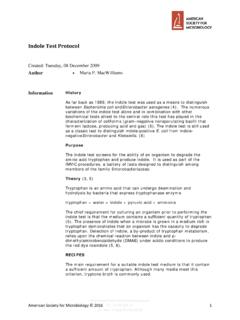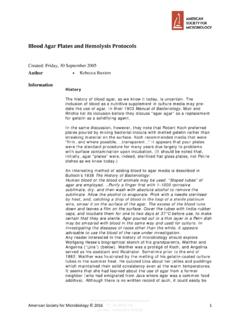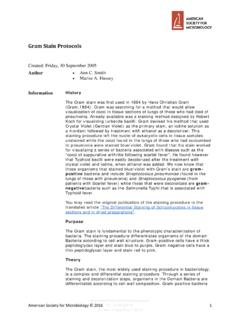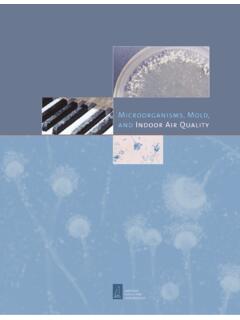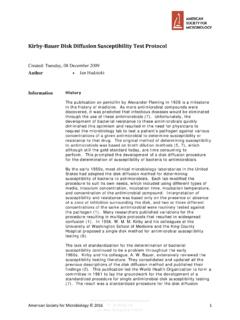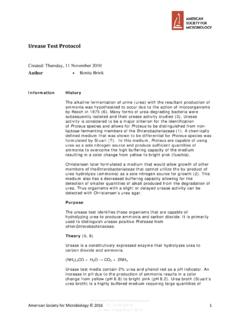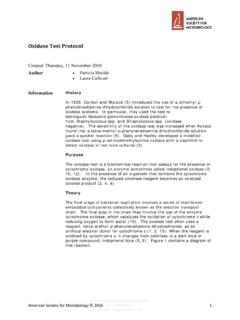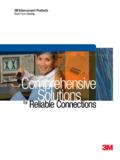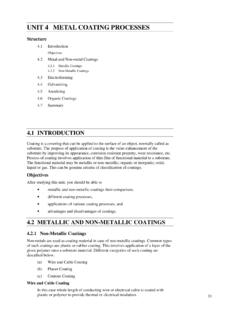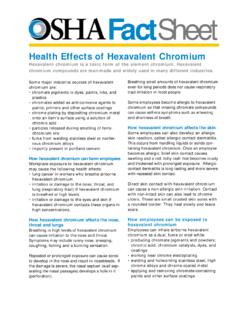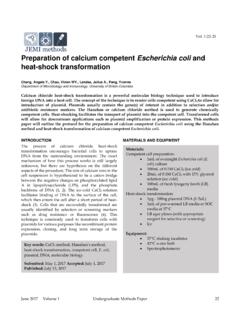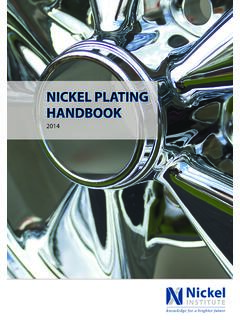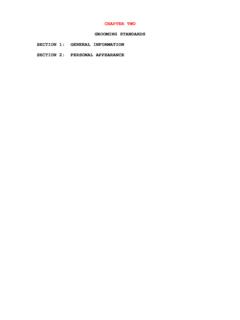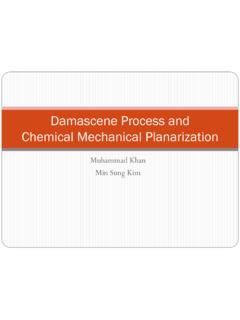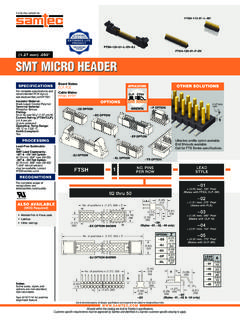Transcription of Luria Broth (LB) and Luria Agar (LA) Media and Their Uses ...
1 Luria Broth (LB) and Luria agar (LA) Media and Their Uses Protocol ||. Created: Monday, 09 October 2006. Author Maria P. MacWilliams Min-Ken Liao Information History LB is a widely used bacterial culture medium today but it has its origins in the field of bacteriophagegenetics. Guiseppi Bertani created the LB. recipe while trying to optimize plaque formation on aShigella indicator strain (Bertani, 1952). According to Bertani, LB has been variously misconstrued to stand for " Luria Broth ", " Luria -Bertani" medium, and "Lennox Broth "; however, the acronym originally stood for "Lysogeny Broth " (Bertani, 2004). The agar form of the medium should be designated LA but it is often referred to as LB. Although originally developed for bacteriophage studies and Shigellagrowth, LB subsequently became the medium of choice for growth of Escherichia coli and other related enteric species. Purposes LB medium is a rich medium that is commonly used to culture members of the Enterobacteriaceae as well as for coliphage plaque assays.
2 LB and related Media (SOC, Terrific Broth , 2xYT, etc) are used extensively in recombinant DNA work and other molecular biology procedures. Often an antibiotic is added to the sterilized medium to select for cells that contain a specific genetic element such as a plasmid, a transposon, or a gene disruption via an antibiotic resistance cassette. X-Gal (5-bromo-4- chloro-3-indolyl-beta-D-galactoside) may be added to sterile medium when using the blue-white screen for plasmids bearing the alpha fragment of the beta-galactosidase gene (a-complementation analysis). IPTG (isopropyl-beta-D-thiogalactopyranoside) is sometimes added to induce expression of genes controlled by the lac promoter. In addition to (or perhaps because of) its prominent position in the molecular biology field, LB has also been used as a general-purpose bacterial culture medium for a variety of facultative organisms. In the undergraduate microbiology teaching labs, LB is sometimes used as the growth surface when attempting to analyze bacterial colony morphology (See LB agar medium images).
3 RECIPE. Many, slightly different recipes for LB exist. LB ( Broth and agar formulation) is also commercially available in a premixed form. Standard Recipe for 1 Liter of LB: Downloaded from by American Society for Microbiology 2016 IP: 1. On: Mon, 12 Aug 2019 20:18:49. (Sambrook and Russell, 2001 Gerhardt, et al. 1994). Tryptone 10 g Yeast Extract 5g NaCl 10 g Dissolve components in 1 liter of distilled or deionized water. For LB agar * add agar to a final concentration of Heat the mixture to boiling to dissolve agar and sterilize by autoclaving at 15 psi, from 121-124 C for 15 minutes. * Strictly speaking, LB agar should be called LA. LB Variations Variations of the LB recipe can be found in the literature and lab manuals. One variation of LB ("Lennox Broth "), calls for the use of 5. grams per liter of NaCl (Lennox, 1955; Gerhardt, et al. 1994). In some research studies, a diluted version of LB ( LB) has been used to culture environmental microbe isolates (Lee, 2000). To isolate marine microbes such as Vibrio spp.
4 , some researchers have used 30 grams per liter of NaCl (Nandi, et al., 2000). Glucose is sometimes added to a final concentration of 1 to 2 grams per liter of medium. Many recipes call for the use of a concentrated NaOH solution (~1-5 M) to adjust the pH to prior to autoclaving. To maximize growth, especially when a carbon source such as glucose is added, phosphate buffer or Tris-HCl buffer may be added to maintain the pH. If the medium is to be used for bacteriophage growth, a sterile stock solution of CaCl2 is often added to a final concentration of x10-3 M after autoclaving. Top agar ( %. agar plus the other LB components) is routinely used for plating of bacteriophage. The use of top agar facilitates diffusion of phage particles (For more information, see Plaque Assay Protocol entry). Other additions and Their purposes (Sambrook and Russell, 2001; Maloy 1990): Chemical Purpose Stock Workin Concentration Concen CaCl2 Bacteriophage lambda infection 1M mM. MgCl2 Bacteriophage P1 infection 1M 20 mM.
5 X-gal Chromogenic substrate for beta- 2% (w/v) galactosidase; screen for recombinant vectors IPTG Nonfermentable lactose analog; 1M induction of lac promoter PROTOCOLS. Streak Plate for Elucidation of Colony Morphologies Streak a plate of LB agar with a pure or mixed bacterial culture. Incubate inverted plate at organism's ideal temperature for 24. to 48 hours. Observe colony morphology. For more information on colony morphology, see Description of Colonial Morphology of Microorganisms. Downloaded from by American Society for Microbiology 2016 IP: 2. On: Mon, 12 Aug 2019 20:18:49. plating of Bacteriophage: See Plaque Assay entry. SAFETY. The ASM advocates that students must successfully demonstrate the ability to explain and practice safe laboratory techniques. For more information, read the laboratory safety section of the ASM Curriculum Recommendations: Introductory Course in Microbiology and the Guidelines for Biosafety in Teaching Laboratories. COMMENTS AND TIPS. This section is to evolve as feedback on the protocol is discussed at ASMCUE.
6 Please contact the project manager for further information. REFERENCES. 1. Bertani, G. 1952. "Studies on Lysogenesis. I. The mode of phage liberation by lysogenicEscherichia coli." J. Bacteriology, 62:293-300. 2. Bertani, G. 2004. "Lysogeny at mid-twentieth century: P1, P2, and other experimental systems." J Bacteriology, (186):595-600. 3. Gerhardt, P., Murray, Wood and Krieg. 1994. "Methods for General and Molecular Bacteriology." ASM Press, Washington, 4. Lee, Y. N. 2003. Calcite Production by Bacillus amyloliquefaciens CMB01 The J. of Microbiology, 41:345-348. 5. Lennox, 1955. "Transduction of linked genetic characters of the host by bacteriophage P1."Virology 1: 190-206. 6. Maloy, S. 1990. Experimental Techniques in Bacterial Genetics.. Jones and Bartlett Publishers, MA. 7. Nandi. B., R. K. Nandy, S. Mukhopadhyay, G. B. Nair, T. Shimada, and A. C. Ghose1. 2000. Rapid Method for Species-Specific Identification of Vibrio cholerae Using Primers Targeted to the Gene of Outer Membrane Protein OmpW J Clinical Microbiology, 38: 4145 4151.
7 8. Sambrook, J and Russell. 2001. "Molecular Cloning, a Laboratory Manual." Cold Spring Harbor Laboratory Press, Cold Spring Harbor, NY. REVIEWERS. This resource was peer-reviewed at ASM Conference for Undergraduate Educators 2006. Participating reviewers: Cynthia Keler Delaware Valley College, Doylestown, PA. James Knapp Holyoke Community College, Holyoke, MA. Don Lehman Downloaded from by American Society for Microbiology 2016 IP: 3. On: Mon, 12 Aug 2019 20:18:49. University of Delaware, Newark, DE. Elise R. Sullivan University of New Hampshire, Durham, NH. Penelope Worthington Creighton University, Omaha, NE. Anne E. Zayaitz Kutztown University of Pennsylvania, Kutztown, PA. Downloaded from by American Society for Microbiology 2016 IP: 4. On: Mon, 12 Aug 2019 20:18:49.
